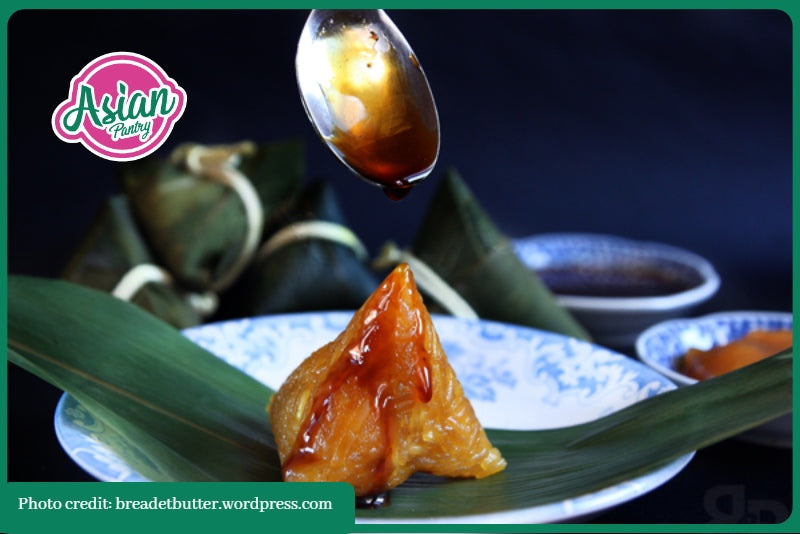Updated: September 2022
What do kee chang, bagels, pretzels and ramen have in common? They all use a unique ingredient called lye water. Lye water is a strong alkaline liquid that changes the consistency and taste of certain foods. For example, it gives the glutinous rice of kee chang its distinct bitter flavour. Or makes Japanese ramen strong and chewy.

What is lye water?
In chemical terms, lye water is potassium carbonate. It doesn’t sound like a food ingredient but it is basically a potent alkaline not unlike soda bicarbonate.
Having a high pH level, lye water creates chemical reactions that produces different flavours and textures. It is often used in Chinese cooking to make a variety of items from noodles and rice to speciality cakes. Usually you won’t even know that lye water is being used as only a very small amount is needed. Lye water, however, is an essential ingredient when a recipe calls for it.
Where to buy lye water?

In the past, lye water for food was made by soaking the ashes of burnt wood in water for 3 months. This creates a potassium hydroxide solution you will need to drain and heat to remove the excess water.
Fortunately, you can now purchase ready-made lye water from selected Asian grocers in Melbourne. It may not be in every Asian grocer you step into but most well-stocked Asian grocers would sell it.
Pun Chun Lye Water is a popular lye water brand bottled in Hong Kong and ready for you to use in your Asian cooking. If you have trouble finding it, just look for a bottle of premixed alkaline solution that may be labelled as ‘potassium carbonate’ or ‘sodium hydroxide’.
If for some reason you are unable to find lye water, you can try making an alternative using soda bicarbonate. This involves baking the soda bicarbonate at 175°C for thirty minutes and adding 4 times the water to create a strong alkaline solution. We would, however, still recommend you to use actual lye water for best results.
Top 3 recipes to make with lye water
Mooncake

Lye water is the secret ingredient that gives mooncake its slightly burnt flavour. It is also responsible for giving mooncake skin that unusual brown colouring. When you add lye water into the mooncake dough, the Maillard effect occurs. This is a chemical reaction that causes the crisping and browning of baked goods.
The strong alkaline levels of lye water produce a chemical reaction between the amino acids and sugars. Think seared streaks, fried dumplings, golden cookies and other ‘browned’ foods that turn delicious when cooked over high heat.
This kind of browning usually occurs at 140 to 165°C. When the temperature is higher, you get a different kind of browning effect – caramelisation – that is, when the sugars turn sticky and aromatic.
Lye water is also important when making mooncakes because of the use of golden syrup. This is an inverted sugar comprising glucose and fructose, as opposed to regular sugar (which is made of sucrose). To make the golden syrup, you boil regular sugar with lemon juice until it becomes a thick, amber syrup.
The lye water (an alkaline) is used to neutralise the acid from the lemon. As a result, you will get a soft delicate pastry without the sour taste. Lye water makes the pastry a dark golden brown. If the colour of your mooncake it still pale after 20 minutes of baking, increasing the amount of lye water you use will help.
Ramen

Ramen is made using three simple ingredients: all-purpose flour, normal water and lye water. The flour is placed into a large mixing bowl. We recommend the best stainless steel mixing bowls which can take intense dough kneading, and which are also durable and lightweight.
When you pour the lye water into the flour, the flour will turn a characteristic yellow hue. The lye water will make the noodles strong and springy so you can roll the dough and stretch it out to very long lengths. It will also prevent the noodles from disintegrating in the soup or water during the cooking stage. Note that lye water is called kansui in Japanese, named after the mineral-rich water obtained from wells in the past. Lye water can also be used to make other noodles such as Chinese handmade noodles.
Kee Chang

Kee chang is a sticky rice dumpling similar to bak chang, both eaten during the Chinese Dragon Boat Festival. The difference is kee chang is usually eaten plain or with a red bean paste inside whereas bak chang is filled with meat and mushrooms.
The sticky rice is mixed with lye water and this is what makes the dumplings chewy and bouncy. The lye water also makes the rice slightly yellow. The glutinous rice is then wrapped in banana leaves and boiled until everything sticks together to form a beautiful triangular shaped dumpling.
Is lye water in your pantry?
Lye water is a humble but potent Chinese ingredient. If you plan to make your own mooncakes, dumplings or noodles, make sure you have a bottle of lye water handy. At Asian Pantry we stock Pun Chun Lye Water and Chen Cun Lye Water.

